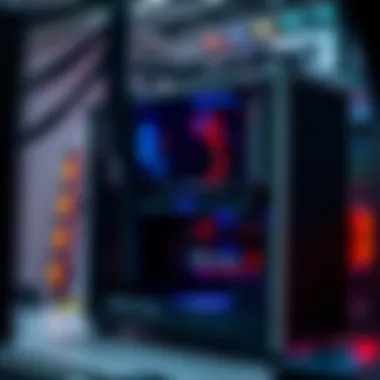Building Your Own Crypto Mining Rig: A Complete Guide


Intro
In the rapidly evolving landscape of digital finance, cryptocurrency mining stands out as both an opportunity and an endeavor fraught with complexities. As individuals dive into the world of crypto, many find themselves curious about the mechanics behind mining—the process by which transactions are validated and added to the blockchain. The excitement surrounding digital currencies creates a compelling case for building your own mining rig. This guide will walk you through the critical components needed, elaborate on the technical know-how for assembly, and discuss ongoing maintenance to ensure your rig operates smoothly.
Cryptocurrency Fundamentals
To venture into mining, one must first grasp the essentials of cryptocurrency.
Understanding Blockchain Technology
At its core, cryptocurrency relies on blockchain technology. Blockchain is a distributed ledger that records transactions across numerous computers, ensuring that the record remains secure and immutable. Each block in the chain contains transaction details, a timestamp, and a cryptographic hash of the previous block, creating a continuous and unalterable chain. As miners solve complex mathematical problems to validate transactions, they effectively work to add new blocks to this chain. This process is not merely about securing funds; it's about maintaining the integrity of the entire network.
Key Points about Blockchain:
- Decentralization: No single entity controls the network.
- Transparency: Transactions are visible to all participants.
- Immutability: Once recorded, a transaction cannot be altered.
Key Concepts in Cryptocurrency Trading
Beyond mining, understanding trading concepts is crucial for navigating the crypto space. Here are a few key terms to keep in mind:
- Altcoin: Refers to any cryptocurrency other than Bitcoin. Popular altcoins include Ethereum, Ripple, and Litecoin.
- Market Cap: The total value of a cryptocurrency, calculated by multiplying its price by the circulating supply.
- Volatility: Cryptocurrencies often experience rapid price changes, making them high-risk investments but also potential avenues for profit.
Understanding these concepts will enhance your ability to strategize and succeed, whether you are trading or mining.
Market Insights
The crypto market operates like a living entity—ever-changing and often unpredictable. To build your mining rig effectively, insights into current market trends and movements are essential.
Current Trends in the Crypto Market
As of late 2023, we observe several noteworthy trends:
- Increased Institutional Adoption: More traditional banks are dipping their toes into the crypto pond, affecting legitimacy and market stability.
- Regulatory Focus: Governments worldwide are scrutinizing cryptocurrencies, which can lead to rapid shifts in the market landscape.
- Technological Advances: Innovations such as layer 2 solutions are helping to enhance transaction speeds and reduce fees.
These trends can directly impact mining efficiency and profitability, making it indispensable for miners to stay informed.
Analyzing Market Movements and Predictions
Understanding market behavior is vital. Historical data indicates patterns that can be leveraged for strategic decisions. It’s beneficial to:
- Monitor Price Changes: Keeping an eye on both individual coins and market trends provides insight into potential future movements.
- Engage with Communities: Platforms like Reddit often feature discussions that can enlighten readers about emerging trends in crypto.
- Utilize Analytical Tools: Various tools allow miners to assess market conditions effectively, ensuring informed decisions.
Building your own mining rig is about more than just hardware; it's an understanding of the ecosystem that underpins digital currencies.
Now that we’ve covered the foundational concepts and market dynamics, the next part will delve into choosing the right components and the step-by-step assembly process essential for a successful mining rig.
Prelims to Crypto Mining
In the vast landscape of digital currencies, understanding the fundamentals of crypto mining is paramount. Mining is not just a technical process; it's the backbone of many cryptocurrencies, creating a whole ecosystem around trust and decentralization. To those unfamiliar, crypto mining involves verifying and adding transaction records to a blockchain, the decentralized ledger that underpins most cryptocurrencies. This article will take you step-by-step through the complexities of building your own mining rig, making sense of the various components and skills you will need.
The ability to mine, while it may sound like something only tech enthusiasts can tackle, is becoming increasingly accessible. With the right guidance, even those with moderate technical skills can venture into this world. A well-constructed mining rig can serve not just as a gateway into earning cryptocurrency but as a fascinating exploration of technology and finance.
It is important to highlight that mining isn't merely a straightforward task of setting up machines to churn out coins. There are several intricacies involved, including selecting suitable hardware, understanding software, and effectively managing the rig once it’s operational. The knowledge gained from this process can prove valuable not just for personal investment, but can also shed light on the broader implications of cryptocurrency's role in the economy.


Understanding Crypto Mining
To truly appreciate crypto mining, one must grasp the underlying principles that guide this endeavor. At its essence, crypto mining serves two interconnected purposes: validating transactions and creating new coins. When miners solve complex mathematical puzzles, they are doing more than just competing to earn rewards; they are facilitating secure transactions across a network.
The mining rewards come in various forms, including transaction fees and newly minted coins, but the potential profitability isn’t guaranteed. Miners must also weigh their investment in hardware and energy costs against the value of the cryptocurrency they aim to earn. Moreover, the rapid evolution of existing mining algorithms and new cryptocurrencies necessitates ongoing adaptability and learning.
The Importance of Mining in Cryptocurrency
The role of mining in cryptocurrency is critical. It ensures the integrity and security of the blockchain. Without miners, the decentralized nature of cryptocurrencies would be compromised. They act like the backbone, maintaining the robust framework that details each transaction made on the network. Moreover, mining promotes a sense of ownership within the community—individual miners can actively participate in the growth and sustainability of the currency.
Additionally, mining supports the broader economy of cryptocurrencies. Each valid transaction incurs a fee, rewarding miners for their efforts in validating transactions, thus encouraging more users to join the ecosystem. This, in turn, fosters trust in a currency that operates without a central authority. The decentralized consensus achieved through mining makes cryptocurrency a revolutionary force in financial systems around the globe.
"Mining is the glue that holds the blockchain together by ensuring all transactions are valid, secure, and irreversible."
From the technical specifications of mining rigs to understanding market dynamics, every chapter in the narrative of crypto mining has its significance. Armed with this foundational knowledge, you are set to navigate the intricacies of building your own mining rig, maximizing efficiency while understanding the impact of your investment in this thrilling field.
Overview of Mining Rig Components
When venturing into the world of crypto mining, comprehending the essentials is crucial. Understanding the components of a mining rig can make or break your operation, paving the way for successful endeavors in cryptocurrency. This section delves into the core components, their significance, and the factors to keep in mind when assembling a rig that fits your mining aspirations.
Essential Hardware for Mining
Graphics Processing Units
Graphics Processing Units (GPUs) play a leading role in crypto mining. They are the workhorses, handling all the computations necessary to validate blocks and earn rewards. A pivotal characteristic of GPUs is their parallel processing capability, allowing them to perform numerous calculations simultaneously. This makes them exceptionally useful for mining cryptocurrencies that depend on intensive mathematical operations.
Among the various types of GPUs, those designed specifically for mining, like the NVIDIA RTX 3080 or AMD Radeon RX 6800 XT, have emerged as popular choices. These models offer higher hash rates, which translate into better performance and increased profit potential. However, keep in mind that GPUs can draw significant power and generate substantial heat, which must be managed effectively to ensure longevity.
Key Takeaway: The choice of GPU directly influences mining efficiency and profitability. Opt for models with a solid track record and favorable reviews from the mining community.
Motherboard
The motherboard is another foundation of your mining rig. It connects all the components, allowing them to communicate with each other. Selecting a motherboard with ample PCIe slots is crucial, particularly if you plan to scale your mining operation with multiple GPUs. A verstile option like the ASUS B250 Mining Expert caters to miners aiming to build expansive setups.
One of the motherboard's unique features is its capacity to support numerous graphics cards. This can be a double-edged sword; while it opens the door for scaling operations, it also complicates the power management and thermal aspects that must be taken into account. Suitable compatibility with your chosen GPUs is vital to prevent headaches down the line.
Power Supply Unit
A reliable Power Supply Unit (PSU) is essential to supply energy to your mining rig. The PSU must have a sufficient wattage rating to handle the total power draw from all connected components. Opting for a high-efficiency unit, such as an EVGA SuperNOVA 1600, ensures that you make the most out of your electricity, translating into better profitability.
The unique selling point of a good PSU is its certified efficiency ratings, often denoted by the 80 PLUS standard. Higher efficiency means less wasted power and heat generation, which can save you money on electricity bills and reduce cooling needs, thus adding to the overall viability of your mining setup.
Cooling System
The cooling system is a critical part of your mining setup. Mining generates a significant amount of heat, and without proper cooling solutions, hardware can overheat, leading to diminished performance or even failure. Options range from basic air cooling to advanced liquid cooling systems.
A common choice is to use high-quality fans to maintain airflow in your mining rig. Some miners prefer aftermarket GPU coolers for enhanced performance. While effective, liquid cooling can be more complex and costly, which is why many stick with robust air cooling solutions. The unique challenge is to strike a balance between cooling performance and noise levels, as too much noise can be a nuisance, especially in a home environment.
Software Requirements for Mining
Mining Software Options
Mining software functions as the interface between your mining hardware and the blockchain network. Selecting the right software is fundamental as it dictates how effectively your rig operates. Well-known options include CGMiner and NiceHash, each offering unique capabilities and features designed to optimize your mining process.


A key characteristic of modern mining software is its compatibility with various cryptocurrencies, allowing miners to switch depending on profitability. However, understanding the configuration process can be somewhat intricate, so those new to mining may need to invest some time into learning the ins and outs to maximize returns.
Wallet Software
Lastly, wallet software plays a vital role in ensuring the security and smooth management of your mined coins. A reputable wallet, such as Exodus or Electrum, provides a user-friendly environment for storing, sending, and receiving cryptocurrencies.
The standout feature of wallet software is its multi-currency support; this means that a miner can manage different coins from a single platform. However, security is of the utmost importance; thus, users should be wary of online wallets prone to hacking. Choosing a wallet that suits your security needs ensures peace of mind as you navigate the world of cryptocurrencies.
Selecting the Right Hardware
When it comes to building your own mining rig, selecting the right hardware is a critical step that shouldn't be overlooked. The components you choose can greatly influence not only the efficiency of your mining rig, but also its overall profitability. The right GPU, motherboard, and power supply are more than just choices; they are foundational elements that directly impact performance and capability.
Choosing GPUs for Efficiency
One of the first decisions in this journey is to select the proper graphics processing units (GPUs). The GPU is essentially the heart of your mining rig. Its efficiency can dictate how quickly you can mine and how much energy you consume in the process. When evaluating GPUs, it's vital to look for specific metrics, such as hash rates and power consumption. An efficient GPU will provide a high hash rate with the least energy expense, which is crucial given that electricity bills can eat into profits.
Key Factors to Consider:
- Hash Rate: This measures the computational power of your GPU. Higher hash rates typically mean faster mining.
- Energy Efficiency: Look for GPUs that have a lower power consumption per hash rate. This helps keep your electricity costs down.
- Cooling Needs: Some GPUs run hotter than others, so think about investing in cooling solutions that complement your rig while also safeguarding your components.
Remember: Not all GPUs benefit every coin equally; it’s worthwhile to evaluate which currencies are best suited for the specific GPUs you consider.
Evaluating Power Needs
Next, one must assess the power needs of the mining rig. This isn't merely about purchasing the most robust power supply. It's about matching your PSU to your system's requirements for optimal performance. An undersized power supply can lead to system instability and even hardware failure.
Steps to Evaluate Power Needs:
- Calculate Total Power Consumption: List all components of your rig along with their power consumption in watts. Add these figures to arrive at a rough estimate of total demand.
- Include Extra Headroom: It's wise to factor in additional capacity, usually about 20% more than your calculations, to ensure reliability and longevity of your rig. This prevents your PSU from running at full capacity constantly, which can degrade its lifespan.
- Consider Efficiency Ratings: Look for power supply units that have certifications like 80 PLUS Gold or Platinum to ensure that your energy use is cost-effective over time.
Motherboard Compatibility
Lastly, the motherboard is the silent overseer of your rig. Not only does it connect all your components, but it also determines how many GPUs you can install and their compatibility with other hardware.
Compatibility Considerations:
- Number of PCIe Slots: Ensure the motherboard has enough PCIe slots to fit your GPUs. Depending on how expansive you want your rig to be, some motherboards can support multiple GPU setups.
- Chipset and RAM Compatibility: Make certain that the motherboard's chipset is compatible with the GPU and has sufficient memory support. Some coins mine better with specific setups due to unique algorithms.
- Power Delivery: Good motherboards often have better power delivery systems, which can affect stability and performance.
By carefully selecting and understanding the hardware components of your mining rig, you increase your chances of optimizing both efficiency and profitability. This foundational knowledge will serve you well as you navigate the complexities of crypto mining.
Building Your Mining Rig
In the expansive world of cryptocurrency, building your own mining rig serves as a crucial stepping stone. It's not just about setting up some parts on a table and plugging them in. This process is a blend of art and science, requiring you to align every component harmoniously to ensure optimal performance while keeping an eye on the costs involved. There’s a liberating feeling from creating something with your own hands, especially when it involves intricate machinery like a mining rig. The benefits extend beyond mere economics; you gain the knack for understanding the technology behind cryptocurrency and the satisfaction of solving problems along the way.
Assembly Step-by-Step
Setting Up the Motherboard
The motherboard is essentially the backbone of your mining rig. It's the hub that anchors the essential components, enabling your GPU, CPU, and other modules to communicate effectively with one another. A high-quality motherboard not only offers durability, but also provides features like multiple PCIe slots, which are paramount when it comes to adding GPUs down the line.
When you’re selecting a motherboard, keep one eye on compatibility. Not all motherboards can host every GPU type. It’s wise to opt for a motherboard specifically designed for mining tasks, as these usually have better thermal management and connectivity options. One particular advantage of mining-specific boards is the inclusion of better power phases, ensuring stable operations even at high loads.
Most mining enthusiasts prefer motherboards from brands like ASUS or MSI, as they have a solid reputation in the mining community. However, remember to verify the specifications meticulously; compatibility can make or break your mining operation.


Installing the GPU
The GPU can be likened to the muscle of your mining rig. It has the critical task of hashing transactions and validating blocks, essentially driving the mining process forward. Installation requires careful handling, as GPUs are sensitive components.
When installing the GPU, ensure it sits snugly in the PCIe slot and connects securely. A distinguishable feature of modern GPUs is their capacity to run multiple processes simultaneously, which contributes significantly to mining efficiency. For instance, GPUs from NVIDIA, particularly the RTX series, are well-regarded due to their high hash rates and energy efficiency.
However, the downside is their price point; high-performance GPUs often come with a tag that could stop the faint of heart. Balancing cost with performance is a delicate dance every miner must learn to master, and in this aspect, it pays off to do thorough research about your options.
Connecting the Power Supply
Once the motherboard and GPU are set, the next major task is connecting the power supply unit (PSU). This component is often overlooked, yet it plays a pivotal role in ensuring your mining rig functions optimally without hitches.
A reliable PSU is characterized by its efficiency rating, usually denoted as 80 Plus certification. This indicates how well it converts AC power to DC power while saving energy. A PSU that delivers around 80% efficiency can significantly reduce electricity costs in the long run, which is crucial considering mining’s aforementioned power hunger.
A significant point to keep in mind while connecting is ensuring that the PSU has enough wattage to handle the total load from the motherboard, GPU, and any other peripheral devices. Skimping here can lead to frustrating shutdowns, overheating, or in the worst-case scenario, component failures. Always err on the side of caution and opt for a PSU with a bit of headroom above your estimated requirements.
Testing the Setup
Once everything is hooked up and in place, it’s time for the moment of truth—testing your mining rig. Initial power-ups should be done cautiously; observe if all fans start spinning and lights illuminate. Beyond just powering it on, you’ll want to enter the BIOS settings to ensure that every component is recognized and running at optimal speeds.
An essential part of testing your setup is to stress-test the rig. Software like MSI Afterburner can facilitate overclocking and monitoring temperatures. Keeping an eye on the thermal performance right from the get-go is vital, as overheating issues can lead to diminished performance or damaged parts.
As with any project, the journey of building a mining rig yields learning experiences that are invaluable. Each step, from assembling components to testing performance, lays the groundwork for enhancing your understanding of cryptocurrency mining—something no textbook can truly encapsulate.
Mining Operations: Getting Started
Getting started with mining operations is a pivotal part of the process when creating your own crypto mining rig. This is where the rubber meets the road. Understanding how to efficiently mine is vital not only to the success of your venture but also to maximize the returns on your investment. Selecting a mining pool and configuring mining software can be the difference between watching your efforts pay off or feeling like you’re just throwing money down the drain.
Choosing a Mining Pool
One of the first decisions you’ll face in the mining process is whether to go solo or join a mining pool. A mining pool is essentially a collective of miners that work together to solve blocks and share the rewards.
- Benefits of Mining Pools
- Stable Income Stream: Mining solo can be as unpredictable as flipping a coin. When joining a pool, you get smaller, more frequent payouts, smoothing out the volatility.
- Resource Sharing: Combining resources allows access to better technology and infrastructure. In a pool, your collective hashing power increases your chances of earning cryptocurrency significantly.
- Skill Levels: For newcomers, a mining pool provides a learning environment. You'll have seasoned miners to lean on for tips and tricks.
However, there are a few considerations to keep in mind:
- Pool Fees: Most pools charge a fee for participation, cutting into your profits. Make sure to choose one with transparent and reasonable fees.
- Reputation: Check the pool's history and user reviews. Pick a well-established pool with a good track record in returns.
Configuring Your Mining Software
After selecting a mining pool, it’s time to dive into configuration of your mining software. This is where the technical side of mining comes into play. The right software can enhance the efficacy of your mining rig, translating your hardware effort into actual crypto coins.
- Selecting Mining Software: There are various software options available depending on the cryptocurrency you are mining. Some popular choices include
- Installation and Setup: Once you've selected software, follow these general steps:
- CGMiner: Highly customizable, suitable for experienced miners.
- BFGMiner: Focuses on ASIC mining, particularly effective if you're using specialized hardware.
- NiceHash: Great for those who want to maximize profits from various algorithms.
- Download the software from an official source to avoid malicious versions.
- Install it on your rig following on-screen instructions.
- Configure the settings, ensuring to enter your wallet address and pool details correctly.
You can refer to the documentation provided by the software developers for detailed guides on installation and configuration.
bash
Example command to start CGMiner
./cgminer -o stratum+tcp://pool.com:3333 -u username -p password



